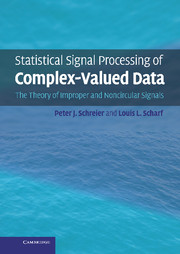Book contents
- Frontmatter
- Contents
- Preface
- Notation
- Part I Introduction
- Part II Complex random vectors
- 3 Second-order description of complex random vectors
- 4 Correlation analysis
- 5 Estimation
- 6 Performance bounds for parameter estimation
- 7 Detection
- Part III Complex random processes
- Appendix 1 Rudiments of matrix analysis
- Appendix 2 Complex differential calculus (Wirtinger calculus)
- Appendix 3 Introduction to majorization
- References
- Index
7 - Detection
from Part II - Complex random vectors
Published online by Cambridge University Press: 25 January 2011
- Frontmatter
- Contents
- Preface
- Notation
- Part I Introduction
- Part II Complex random vectors
- 3 Second-order description of complex random vectors
- 4 Correlation analysis
- 5 Estimation
- 6 Performance bounds for parameter estimation
- 7 Detection
- Part III Complex random processes
- Appendix 1 Rudiments of matrix analysis
- Appendix 2 Complex differential calculus (Wirtinger calculus)
- Appendix 3 Introduction to majorization
- References
- Index
Summary
Detection is the electrical engineer's term for the statistician's hypothesis testing. The problem is to determine which of two or more competing models best describes experimental measurements. If the competition is between two models, then the detection problem is a binary detection problem. Such problems apply widely to communication, radar, and sonar. But even a binary problem can be composite, which is to say that one or both of the hypotheses may consist of a set of models. We shall denote by H0 the hypothesis that the underlying model, or set of models, is M0 and by H1 the hypothesis that it is M1.
There are two main lines of development for detection theory: Neyman–Pearson and Bayes. The Neyman–Pearson theory is a frequentist theory that assigns no prior probability of occurrence to the competing models. Bayesian theory does. Moreover, the measure of optimality is different. To a frequentist the game is to maximize the detection probability under the constraint that the false-alarm probability is not greater than a prespecified value. To a Bayesian the game is to assign costs to incorrect decisions, and then to minimize the average (or Bayes) cost. The solution in any case is to evaluate the likelihood of the measurement under each hypothesis, and to choose the model whose likelihood is higher. Well – not quite. It is the likelihood ratio that is evaluated, and when this ratio exceeds a threshold, determined either by the false-alarm rate or by the Bayes cost, one or other of the hypotheses is accepted.
- Type
- Chapter
- Information
- Statistical Signal Processing of Complex-Valued DataThe Theory of Improper and Noncircular Signals, pp. 177 - 194Publisher: Cambridge University PressPrint publication year: 2010



